|
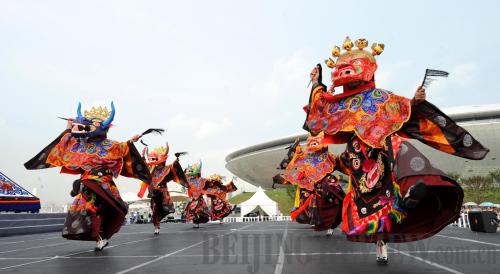 |
|
DRAMATIC PERFORMANCE: Tibetan artists perform at the World Expo, September 1 (CHOGO) | It is not hard to see why the Tibet pavilion is so popular; its combination of beautiful decor, informative exhibits and striking displays of Tibetan culture have made it one of the highlights of the China Provincial Joint Pavilion.
Its facade features snowcapped mountains, blue skies and vast plateaus that make up the Tibetan landscape. The entrance to the pavilion is decorated with a five-color ribbon, reminiscent of the colorful skirts worn by Tibetan women. Two long, white ribbons wrap around the entire building. According to pavilion guides, one ribbon symbolizes the white hada, a traditional ceremonial scarf. The other ribbon represents the gleaming white mountains that stretch across Tibet.
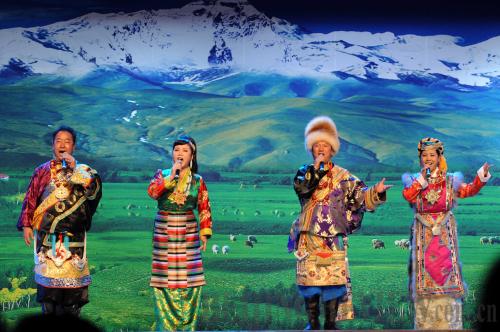 |
|
A HAPPY GET-TOGETHER: Singers perform at the opening ceremony of Tibet Week at the World Expo in Shanghai, September 1. More than 400 performers from China's Tibet Autonomous Region have taken part in various activities during Tibet Week (CHOGO) | The pavilion is separated into three sections. The first section, Happy Heavenly Road, showcases a replica of a Qinghai-Tibet Railway train. Eight LED screens on the train's windows display some of the beautiful scenery visible from the railway. Antelopes dashing across the plateau, vast swaths of grass-covered plains and crystal-clear lakes are all part of Tibet's natural landscape, and all can be seen in this section of the pavilion.
The importance of the Qinghai-Tibet Railway is evident in this section. The Qinghai-Tibet Railway has been a great boon to the region. As one of the biggest links to the "Roof of the World," the railway has greatly boosted foreign and domestic investment in Tibet since it went into service in 2006. The railway has also increased the number of visitors to Tibet. The autonomous region saw 78,000 guests in just the first half of 2010.
In another section of the pavilion, a large mural titled Tashi Delek ("good luck" in Tibetan) is displayed. The mural is an enlarged version of a painting in the Great Hall of the People in Beijing.
Originally conceived by famed Chinese painter Ye Xingsheng, the original painting in Beijing required five years of work by a team of artists comprising Tibetans and members of the Han and Hui ethnic groups. Featuring elements of folklore related to the Tibetan New Year, the mural displays a wide variety of animals, auspicious symbols and other figures.
"Having been in the Great Hall of the People for 30 years, the Tashi Delek is a new milestone for Tibetan mural art. The reason for its premiere at the World Expo is that it fully reflects the vigorous spirit felt by Tibetans after they became masters of their own destiny following the democratic reform launched in 1959," said Ye.
Elsewhere in the pavilion, guests can visit a mini-cinema where they can watch a movie about the rich social and religious customs of Tibet. The movie also celebrates the remarkable achievements Tibet has made in recent years. The improvement of its infrastructure and the preservation of its natural resources and cultural heritage are all featured in the film. Tibet has seen remarkable economic growth since the reform of 1959; its GDP exploded from 174 million yuan ($25.4 million) in 1959 to nearly 40 billion yuan ($5.78 billion) in 2008. Average life expectancy also soared during this time from 36 years to about 67 years now.
Visitors to the Tibet Pavilion also have a chance to rest in an authentic Tibetan-style sitting room. The sitting room is a replica of those found in many Tibetan homes, complete with traditional Tibetan furniture, silk tangkas (scroll paintings) and handmade Tibetan dolls. In addition to these cultural treasures, the sitting room also houses modern household appliances, making it a curious combination of contemporary and ancient traditions. These "modern houses with Tibetan characteristics" are quite common in Tibet these days. Since January of 2006, approximately 1.4 million herdsmen and peasants have moved into these modernized homes.
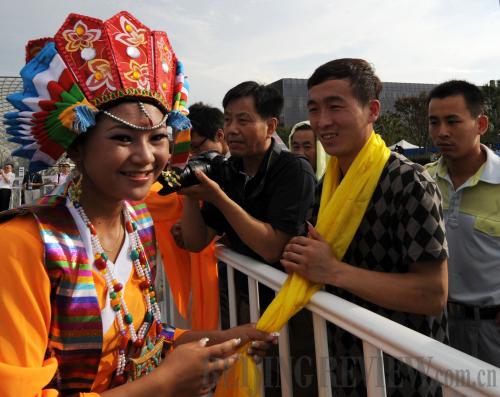 |
| HOSPITALITY: A Tibetan actress presents a traditional Tibetan hada, a symbol of blessings, to a tourist during a performance at the World Expo, September 1 (CHOGO) |
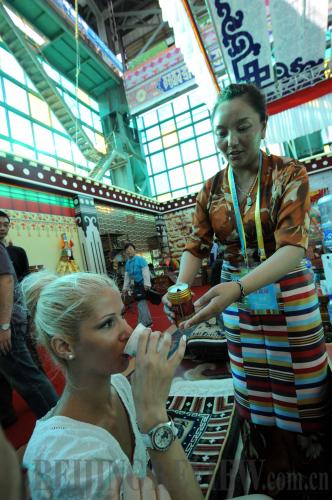 |
| A TASTE OF TIBET: A Turkish tourist tastes barley liquor, a traditional Tibetan alcoholic drink, September 3 (CHOGO) |
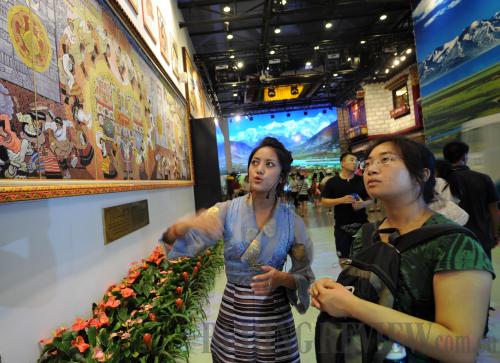 |
| TRADITIONAL ART: Staff at the Tibet Pavilion introduces a traditional mural to a visitor, September 5 (CHOGO) |
|
